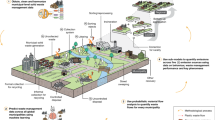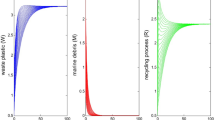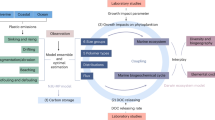Abstract
The infrastructure available to a nation for the management of its solid waste not only affects its population and environment, it plays a role in addressing global challenges of greenhouse gas emissions and ocean plastics. Several approaches attempt to address this purpose, but their adoption is dependent on available resources. While nations in the global south struggle with waste collection and rely heavily on open dumping, those in the global north invest in more advanced technologies to divert materials from disposal to recovery. To address cross-border waste concerns, a more in-depth understanding of the cost–benefit relationship of different strategies is required. Here we show that investment in advancing the waste infrastructure of the global south achieves a higher mitigation of greenhouse gas emissions and marine plastics than further upgrades in the global north. Basic collection is the essential step to reducing marine plastics, and a transition from open dumps and burning to controlled landfills does more to reduce methane and black carbon emissions than upgrading existing systems to advanced technologies. Our results demonstrate how targeted expenditures towards basic infrastructure components in those areas with the least investment are a more efficient use of global resources for mitigating climate change and reducing marine plastics.
This is a preview of subscription content, access via your institution
Access options
Access Nature and 54 other Nature Portfolio journals
Get Nature+, our best-value online-access subscription
$32.99 / 30 days
cancel any time
Subscribe to this journal
Receive 12 digital issues and online access to articles
$119.00 per year
only $9.92 per issue
Buy this article
- Purchase on SpringerLink
- Instant access to full article PDF
Prices may be subject to local taxes which are calculated during checkout



Similar content being viewed by others
Data availability
All data used to produce the results of our analysis are available in the Supplementary Information and Supplementary Data A–E, which provide data on waste disposition and composition flows, WM cost, GHG emissions footprints and emission factors, plastic marine debris footprints and the impacts of cost, GHG emissions and plastic marine debris when improving WM classification levels.
References
Kaza, S., Yao, L. C., Bhada-Tata, P. & Van Woerden, F. What a Waste 2.0: A Global Snapshot of Solid Waste Management to 2050 (World Bank, 2018).
Hoy, Z. X., Woon, K. S., Chin, W. C., Van Fan, Y. & Yoo, S. J. Curbing global solid waste emissions toward net-zero warming futures. Science 382, 797–800 (2023).
Borrelle, S. B. et al. Predicted growth in plastic waste exceeds efforts to mitigate plastic pollution. Science 369, 1515–1518 (2020).
Bogner, J. et al. in Climate Change 2007: Mitigation of Climate Change (eds Metz, B. et al.) Ch. 10 (Cambridge Univ. Press, 2007).
Zero Waste to Zero Emissions (GAIA, accessed 8 April 2024); https://www.no-burn.org/zerowaste-zero-emissions/
Powell, J. T., Townsend, T. G. & Zimmerman, J. B. Estimates of solid waste disposal rates and reduction targets for landfill gas emissions. Nat. Clim. Change 6, 162–165 (2016).
Cusworth, D. H. et al. Quantifying methane emissions from United States landfills. Science 383, 1499–1504 (2024).
Jambeck, J. R. et al. Plastic waste inputs from land into the ocean. Science 347, 768–771 (2015).
Kaandorp, M. L. A., Lobelle, D., Kehl, C., Dijkstra, H. A. & van Sebille, E. Global mass of buoyant marine plastics dominated by large long-lived debris. Nat. Geosci. 16, 689–694 (2023).
Lebreton, L. & Andrady, A. Future scenarios of global plastic waste generation and disposal. Palgrave Commun. 5, 6 (2019).
Zhang, Y. et al. Plastic waste discharge to the global ocean constrained by seawater observations. Nat. Commun. 14, 1372 (2023).
Forging a Path Beyond Borders: The Global South UNCTAD/OSG/2018/1 (UNCTAD, 2018); https://unctad.org/system/files/official-document/osg2018d1_en.pdf
Meijer, L. J. J., van Emmerik, T., van der Ent, R., Schmidt, C. & Lebreton, L. More than 1000 rivers account for 80% of global riverine plastic emissions into the ocean. Sci. Adv. 7, eaaz5803 (2021).
Gómez-Sanabria, A., Kiesewetter, G., Klimont, Z., Schoepp, W. & Haberl, H. Potential for future reductions of global GHG and air pollutants from circular waste management systems. Nat. Commun. 13, 106 (2022).
Duren, R. M. et al. California’s methane super-emitters. Nature 575, 180–184 (2019).
Anshassi, M., Laux, S. J. & Townsend, T. G. Approaches to integrate sustainable materials management into waste management planning and policy. Resour. Conserv. Recycl. 148, 55–66 (2019).
Tumu, K., Vorst, K. & Curtzwiler, G. Global plastic waste recycling and extended producer responsibility laws. J. Environ. Manag. 348, 119242 (2023).
Anshassi, M. & Townsend, T. G. The hidden economic and environmental costs of eliminating kerb-side recycling. Nat. Sustain. 6, 919–928 (2023).
Andreasi Bassi, S., Tonini, D., Ekvall, T. & Astrup, T. F. A life cycle assessment framework for large-scale changes in material circularity. Waste Manag. 135, 360–371 (2021).
Nicolli, F. & Mazzanti, M. Landfill diversion in a decentralized setting: a dynamic assessment of landfill taxes. Resour. Conserv. Recycl. 81, 17–23 (2013).
Diversion of Waste From Landfill in Europe (EEA, 2024); www.eea.europa.eu/en/analysis/indicators/diversion-of-waste-from-landfill
Bridging the Gap in Solid Waste Management Governance Requirements for Results (World Bank, 2021).
Roy, D. & Tarafdar, A. in Circular Economy in Municipal Solid Waste Landfilling: Biomining & Leachate Treatment (eds Pathak, P. & Palani, S. G.) 1–23 (Springer International, 2022).
Xu, T. et al. Evolving patterns and drivers of waste plastic trade in key global economies. Resour. Conserv. Recycl. 206, 107606 (2024).
Houssini, K., Li, J. & Tan, Q. Complexities of the global plastics supply chain revealed in a trade-linked material flow analysis. Commun. Earth Environ. 6, 257 (2025).
Thanos Bourtsalas, A. C., Yepes, I. M. & Tian, Y. U.S. plastic waste exports: a state-by-state analysis pre- and post-China import ban. J. Environ. Manag. 344, 118604 (2023).
Navarre, N., Mogollón, J. M., Tukker, A. & Barbarossa, V. Recycled plastic packaging from the Dutch food sector pollutes Asian oceans. Resour. Conserv. Recycl. 185, 106508 (2022).
Bishop, G., Styles, D. & Lens, P. N. L. Recycling of European plastic is a pathway for plastic debris in the ocean. Environ. Int. 142, 105893 (2020).
Cook, E., Silva de Souza Lima Cano, N. & Velis, C. A. Informal recycling sector contribution to plastic pollution mitigation: a systematic scoping review and quantitative analysis of prevalence and productivity. Resour. Conserv. Recycl. 206, 107588 (2024).
Velis, C. Waste pickers in global south: informal recycling sector in a circular economy era. Waste Manag. Res. 35, 329–331 (2017).
Labra Cataldo, N., Gallego-Schmid, A. & McLachlan, C. Waste pickers in the global south: understanding the key features that underpin the dominance of informality. Sustain. Sci. Pract. Policy 21, 2478697 (2025).
On Waste and Repealing Certain Directives. Waste Directive 2008/98/EC (European Commission, 2008).
Hoogmartens, R., Eyckmans, J. & Van Passel, S. Landfill taxes and enhanced waste management: combining valuable practices with respect to future waste streams. Waste Manag. 55, 345–354 (2016).
Gómez-Maldonado, A., Ospina-Espita, L. C., Rodríguez-Lesmes, P. & Rodríguez-Rodriguez, M. A. Barriers and opportunities for waste pickers within solid waste management policy in Colombia. Waste Manag. 163, 1–11 (2023).
Nogueira Zon, J. L., Jacobsen Leopoldino, C., Yamane, L. H. & Ribeiro Siman, R. Waste pickers organizations and municipal selective waste collection: sustainability indicators. Waste Manag. 118, 219–231 (2020).
Schmidt, C., Krauth, T. & Wagner, S. Export of plastic debris by rivers into the sea. Environ. Sci. Technol. 51, 12246–12253 (2017).
Lebreton, L. C. M. et al. River plastic emissions to the world’s oceans. Nat. Commun. 8, 15611 (2017).
Cottom, J. W., Cook, E. & Velis, C. A. A local-to-global emissions inventory of macroplastic pollution. Nature 633, 101–108 (2024).
Levis, J. W., Barlaz, M. A., DeCarolis, J. F. & Ranjithan, S. R. A generalized multistage optimization modeling framework for life cycle assessment-based integrated solid waste management. Environ. Model. Softw. 50, 51–65 (2013).
Krause, M. J. Intergovernmental panel on climate change’s landfill methane protocol: reviewing 20 years of application. Waste Manag. Res. 36, 827–840 (2018).
2006 IPCC Guidelines for National Greenhouse Gas Inventories (IPCC, 2006).
Anshassi, M., Smallwood, T. & Townsend, T. G. Life cycle GHG emissions of MSW landfilling versus incineration: expected outcomes based on US landfill gas collection regulations. Waste Manag. 142, 44–54 (2022).
Chancel, L. Global carbon inequality over 1990–2019. Nat. Sustain. 5, 931–938 (2022).
Emissions Gap Report 2024: No More Hot Air…Please! (UNEP, 2024); www.unep.org/resources/emissions-gap-report-2024
Damgaard, A., Riber, C., Fruergaard, T., Hulgaard, T. & Christensen, T. H. Life-cycle-assessment of the historical development of air pollution control and energy recovery in waste incineration. Waste Manag. 30, 1244–1250 (2010).
Pfadt-Trilling, A. R., Volk, T. A. & Fortier, M.-O. P. Climate change impacts of electricity generated at a waste-to-energy facility. Environ. Sci. Technol. 55, 1436–1445 (2021).
Astrup, T. F., Tonini, D., Turconi, R. & Boldrin, A. Life cycle assessment of thermal waste-to-energy technologies: review and recommendations. Waste Manag. 37, 104–115 (2015).
Anshassi, M. & Townsend, T. G. Reviewing the underlying assumptions in waste LCA models to identify impacts on waste management decision making. J. Clean. Prod. 313, 127913 (2021).
Paulillo, A., Sebastiani, A., Lettieri, P. & Materazzi, M. Decarbonising waste-to-energy: a life cycle assessment study. Resour. Conserv. Recycl. 209, 107812 (2024).
Water Pollution by Plastics and Microplastics: A Review of Technical Solutions From Source To Sea (UNEP, 2020).
Lau, W. W. Y. et al. Evaluating scenarios toward zero plastic pollution. Science 369, 1455–1461 (2020).
Pottinger, A. S. et al. Pathways to reduce global plastic waste mismanagement and greenhouse gas emissions by 2050. Science 386, 1168–1173 (2024).
Waste Management and the Circular Economy in Selected OECD Countries: Evidence from Environmental Performance Reviews (OECD, 2019).
Lebanon Emergency Reconstruction and Rehabilitation Project Solid Waste and Environmental Management Project Performance Assessment Report (World Bank, 2007).
Transitioning to a Circular Economy: An Evaluation of the World Bank Group’s Support for Municipal Solid Waste Management (2010–20) (World Bank, 2022).
Action Plan for Circular Economy: National Plan for Prevention and Management of Waste 2020–2032 (Ministry of Environment of Denmark, 2021).
Kotchen, M. J., Rising, J. A. & Wagner, G. The costs of ‘costless’ climate mitigation. Science 382, 1001–1003 (2023).
Improvement of Solid Waste Management to Support Regional and Metropolitan Cities Project for Indonesia (World Bank, 2020).
Matheson, T. Disposal is Not Free: Fiscal Instruments to Internalize the Environmental Costs of Solid Waste (IMF, 2019).
End Plastic Pollution: Towards an International Legally Binding Instrument UNEP/EA.5/Res.14 (UNEP, 2022).
Waste Wise Cities Tool: Step by Step Guide to Assess a City’s Municipal Solid Waste Management Performance through SDG Indicator 11.6.1 Monitoring (UN Habitat, 2021).
Whiteman, A., Webster, M. & Wilson, D. C. The nine development bands: a conceptual framework and global theory for waste and development. Waste Manag. Res. 39, 1218–1236 (2021).
Hiraishi, T., Nyenzi, B. & Miguez, J. D. IPCC Good Practice Guidance and Uncertainty Management in National Greenhouse Gas Inventories Ch. 5 (IPCC, 2019).
Sardarmehni, M., Anchieta, P. H. C. & Levis, J. W. Solid waste optimization life-cycle framework in Python (SwolfPy). J. Ind. Ecol. 26, 748–762 (2022).
SWM-GHG Calculator—Life Cycle Assessment Approach (IFEU, accessed 8 April 2024); https://www.ifeu.de/en/project/klimarechner-abfallwirtschaft-2023
Solid Waste Emissions Estimation Tool (SWEET) (US EPA, accessed 8 April 2024); www.ccacoalition.org/resources/solid-waste-emissions-estimation-tool-sweet
Reducing Greenhouse Gas Emissions through Inclusive Recycling (WIEGO, accessed 10 April 2025); www.wiego.org/advocacy-worker-education-resources/ghg/
Global Waste Management Outlook 2024: Beyond an Age of Waste—Turning Rubbish into a Resource (UNEP, 2024).
D-Waste (Waste Atlas, accessed 25 October 2023); www.atlas.d-waste.com/
Hoornweg, D. & Bhada-Tata, P. What a Waste: A Global Review of Solid Waste Management (World Bank, 2012); http://documents.worldbank.org/curated/en/302341468126264791
UNSD Environmental Indicators (UNSD, accessed 26 October 2023); https://unstats.un.org/unsd/envstats/qindicators
Population, Total—United States (World Bank, accessed 25 October 2023); https://data.worldbank.org/indicator/SP.POP.TOTL?locations=US
Population Databases (UN, accessed 25 October 2023); https:// databank.worldbank.org/source/population-estimates-andprojections
Global Waste Management Outlook (UNEP, 2015).
Transparency and Reporting Greenhouse Gas Emissions (UNFCCC, accessed 28 October 2023); https://unfccc.int/process-and-meetings/transparency-and-reporting/greenhouse-gas-data/information-on-data-sources
Mai, L. et al. Global riverine plastic outflows. Environ. Sci. Technol. 54, 10049–10056 (2020).
Weiss, L. et al. The missing ocean plastic sink: gone with the rivers. Science 373, 107–111 (2021).
Acknowledgements
This work was financially supported by the Hinkley Center for Solid and Hazardous Waste Management in Gainesville, Florida, USA. We appreciate the access to the life-cycle assessment models SWOLF provided by North Carolina State University. The authors are responsible for the content of the paper and the findings do not represent the views of the funding agencies.
Author information
Authors and Affiliations
Contributions
M.A. performed the research and analysed the data. T.G.T. conceived the idea and designed the study. Both authors wrote the paper.
Corresponding author
Ethics declarations
Competing interests
The authors declare no competing interests.
Peer review
Peer review information
Nature Sustainability thanks Amy Brooks, Ed Cook and the other, anonymous, reviewer(s) for their contribution to the peer review of this work.
Additional information
Publisher’s note Springer Nature remains neutral with regard to jurisdictional claims in published maps and institutional affiliations.
Extended data
Extended Data Fig. 1 2020 breakdown contributions of each WM level, income level, and region to total population.
2020 breakdown contributions of each WM level, income level, and region to total population (7.76 billion people), waste generated (2.09 billion Mg), waste collected (1.69 billion Mg), open dump landfilled (663.3 million Mg), controlled landfilled (231.6 million Mg), sanitary landfilled (434.0 million Mg), open air burned (216.7 million Mg), MSW incinerated (216.6 million Mg), composted (83.9 million Mg), recycled (250.1 million Mg), MSW mismanaged (973.8 million Mg), waste-based GHG emissions (955.5 billion kgCO2eq.), and plastic marine debris (4.42 million Mg). The contributions of each a) waste management level; b) income level; and c) region.
Extended Data Fig. 2 Global waste management flows for 2020.
Flow of the 2.09 billion Mg of generated waste by each a) region and b) income level.
Extended Data Fig. 3 Average greenhouse gas (GHG) emissions footprint for each waste management level on a) a totals basis and b) per person basis.
Values for 3B were determined by taking the total emissions footprint and dividing by the total population of each level (for example, population of all level 1 countries).
Extended Data Fig. 4 Modeled waste-based GHG emissions footprint in units of kgCO2eq./ Mg waste generated for each country under a) current waste management levels and b) improved waste management levels.
More detailed information on the approaches used to estimate conditions for a and b are provided in the Supplementary Methods and Extended Data C.
Extended Data Fig. 5 Modeled plastic emissions into the marine environment in units of kg plastic/ Mg waste generated for each country under a) current waste management levels and b) improved waste management levels.
More detailed information on the approaches used to estimate conditions for a and b are provided in the Supplementary Methods and Extended Data D.
Supplementary information
Supplementary Information
Supplementary Methods, Figs. 1 and 2 and Tables 1–28.
Supplementary Data A
Spreadsheet including WM statistics.
Supplementary Data B
Spreadsheet including WM cost.
Supplementary Data C
Spreadsheet including WM GHG modelling.
Supplementary Data D
Spreadsheet including WM-based plastic marine footprints.
Supplementary Data E
Spreadsheet including WM impacts to improvement.
Rights and permissions
Springer Nature or its licensor (e.g. a society or other partner) holds exclusive rights to this article under a publishing agreement with the author(s) or other rightsholder(s); author self-archiving of the accepted manuscript version of this article is solely governed by the terms of such publishing agreement and applicable law.
About this article
Cite this article
Anshassi, M., Townsend, T.G. Improving waste systems in the global south to tackle international environmental impacts. Nat Sustain 8, 936–946 (2025). https://doi.org/10.1038/s41893-025-01607-8
Received:
Accepted:
Published:
Issue date:
DOI: https://doi.org/10.1038/s41893-025-01607-8



